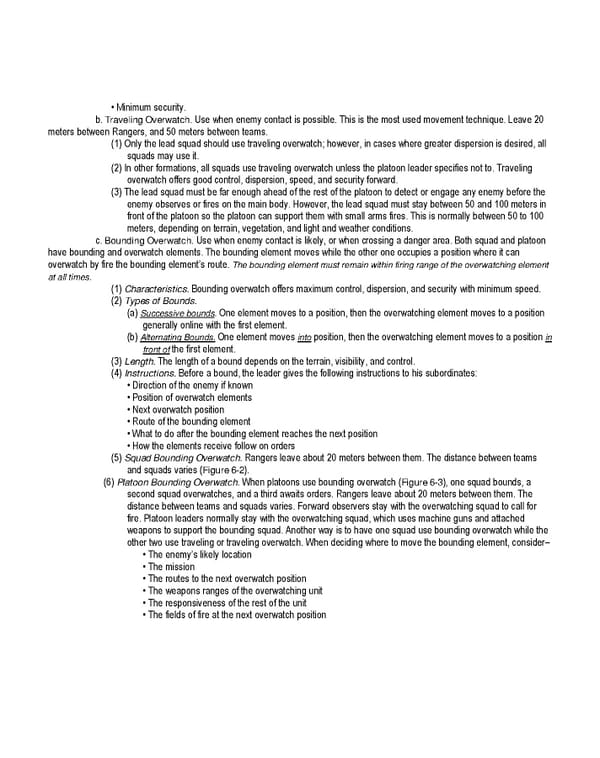• Minimum security. b. Traveling Overwatch. Use when enemy contact is possible. This is the most used movement technique. Leave 20 meters between Rangers, and 50 meters between teams. (1) Only the lead squad should use traveling overwatch; however, in cases where greater dispersion is desired, all squads may use it. (2) In other formations, all squads use traveling overwatch unless the platoon leader specifies not to. Traveling overwatch offers good control, dispersion, speed, and security forward. (3) The lead squad must be far enough ahead of the rest of the platoon to detect or engage any enemy before the enemy observes or fires on the main body. However, the lead squad must stay between 50 and 100 meters in front of the platoon so the platoon can support them with small arms fires. This is normally between 50 to 100 meters, depending on terrain, vegetation, and light and weather conditions. c. Bounding Overwatch. Use when enemy contact is likely, or when crossing a danger area. Both squad and platoon have bounding and overwatch elements. The bounding element moves while the other one occupies a position where it can overwatch by fire the bounding element’s route. The bounding element must remain within firing range of the overwatching element at all times. (1) Characteristics. Bounding overwatch offers maximum control, dispersion, and security with minimum speed. (2) Types of Bounds. (a) Successive bounds (b) . One element moves to a position, then the overwatching element moves to a position generally online with the first element. Alternating Bounds. One element moves into position, then the overwatching element moves to a position in front of (3) Length. The length of a bound depends on the terrain, visibility, and control. the first element. (4) Instructions. Before a bound, the leader gives the following instructions to his subordinates: • Direction of the enemy if known • Position of overwatch elements • Next overwatch position • Route of the bounding element • What to do after the bounding element reaches the next position • How the elements receive follow on orders (5) Squad Bounding Overwatch. Rangers leave about 20 meters between them. The distance between teams and squads varies (Figure 6-2). (6) Platoon Bounding Overwatch. When platoons use bounding overwatch (Figure 6-3), one squad bounds, a second squad overwatches, and a third awaits orders. Rangers leave about 20 meters between them. The distance between teams and squads varies. Forward observers stay with the overwatching squad to call for fire. Platoon leaders normally stay with the overwatching squad, which uses machine guns and attached weapons to support the bounding squad. Another way is to have one squad use bounding overwatch while the other two use traveling or traveling overwatch. When deciding where to move the bounding element, consider– • The enemy’s likely location • The mission • The routes to the next overwatch position • The weapons ranges of the overwatching unit • The responsiveness of the rest of the unit • The fields of fire at the next overwatch position
 Ranger Handbook Page 101 Page 103
Ranger Handbook Page 101 Page 103